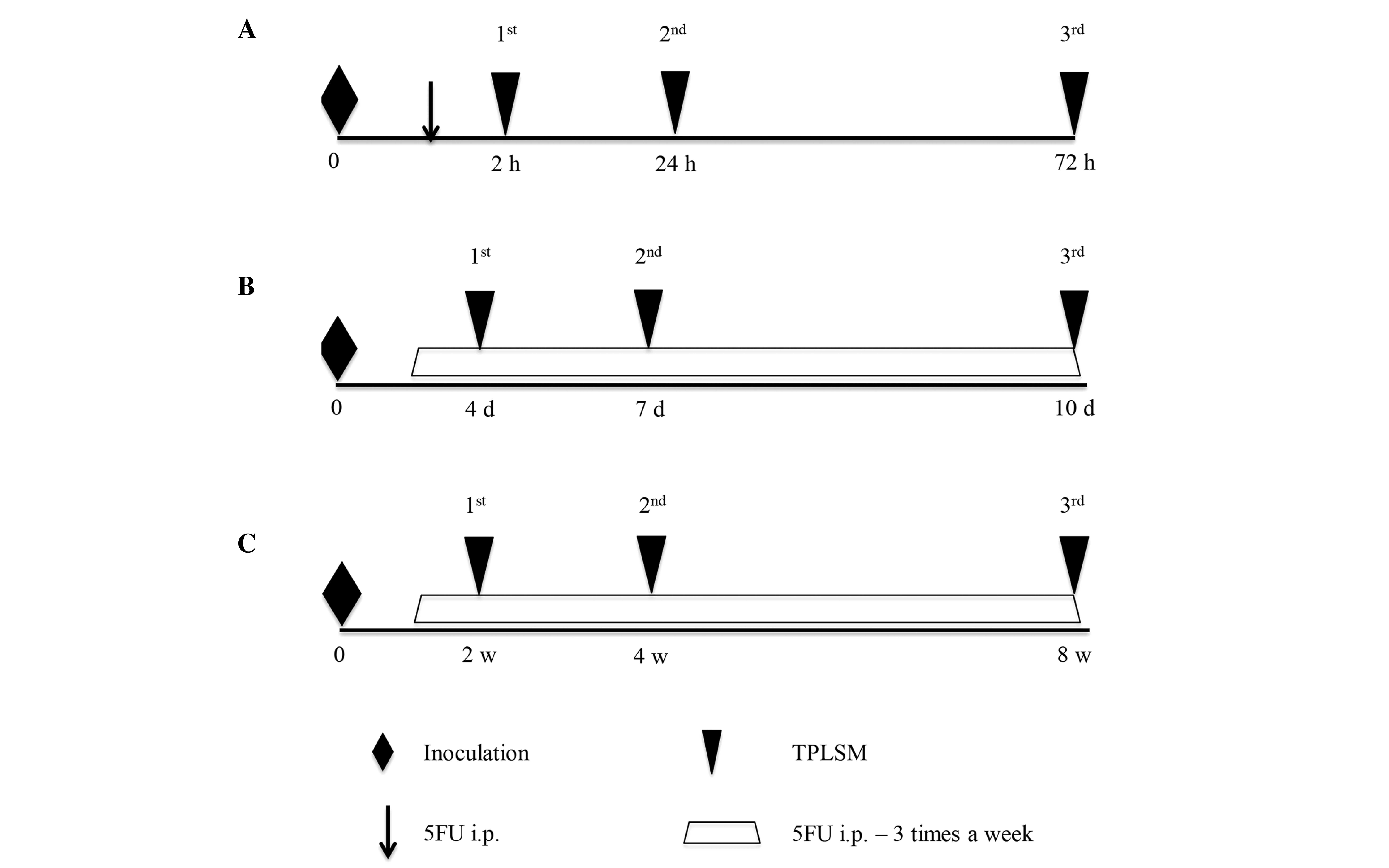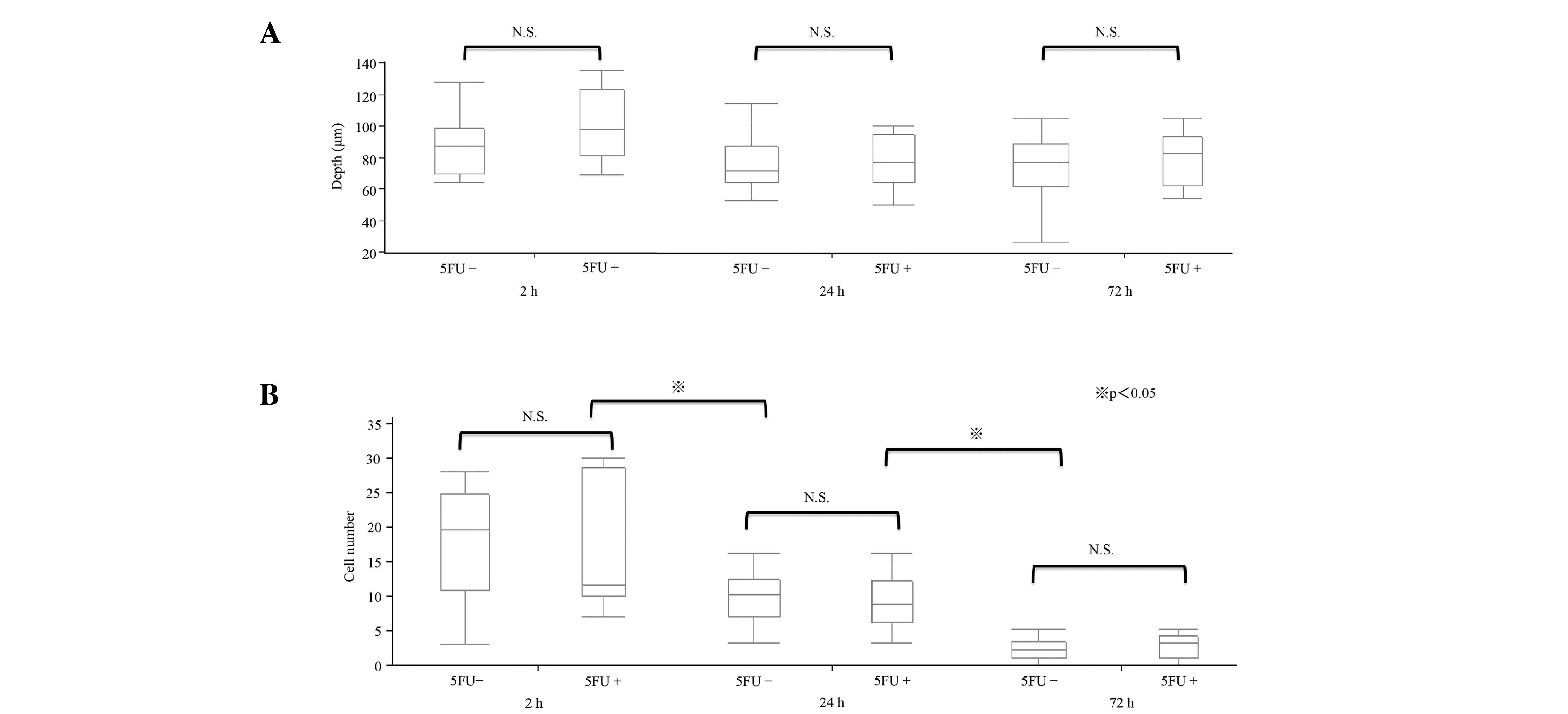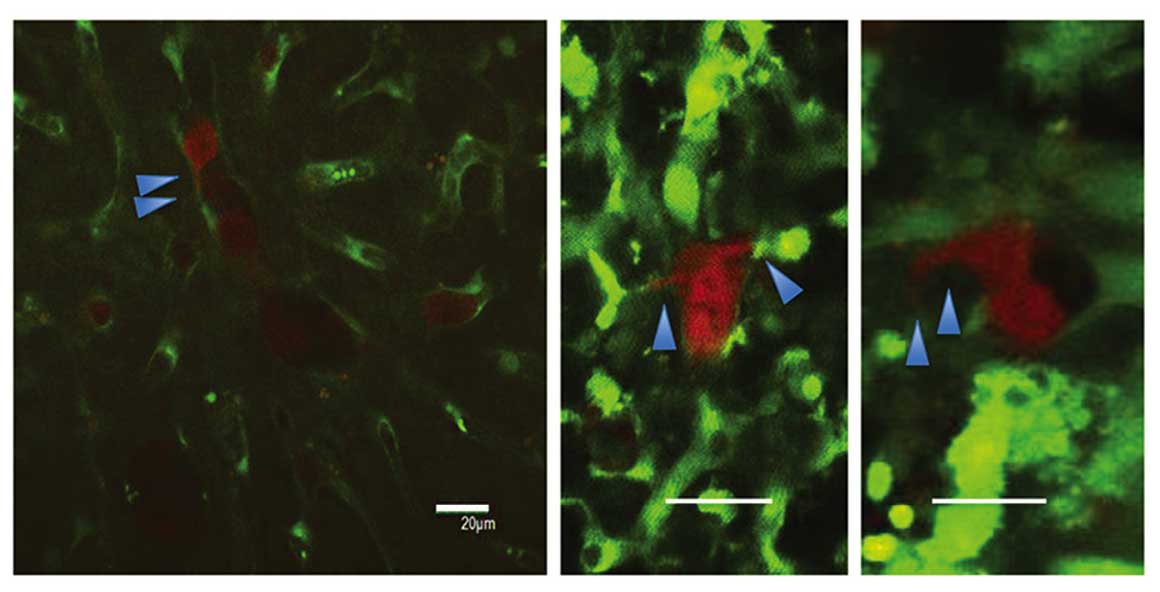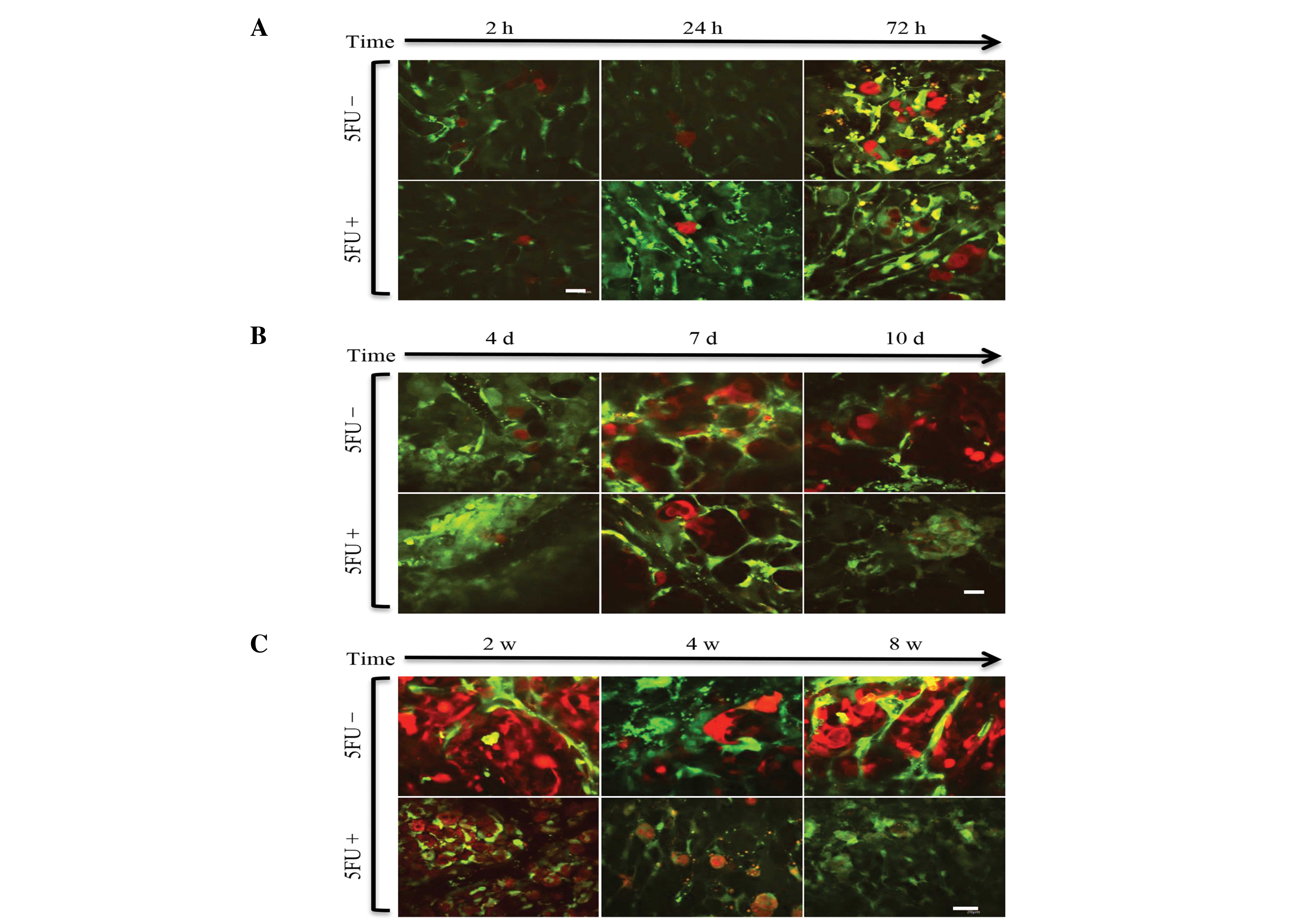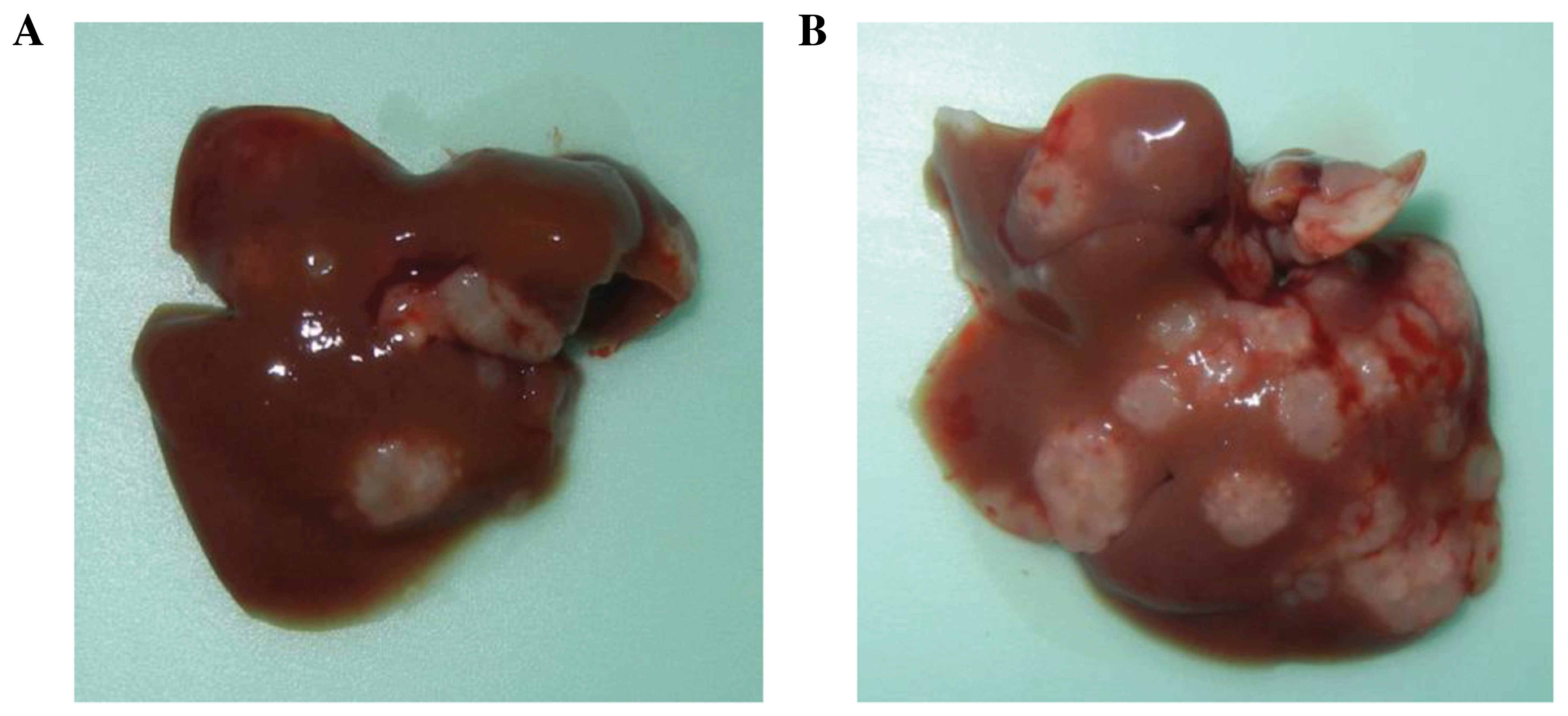|
1
|
Desch CE, Benson AB III, Somerfield MR,
Flynn PJ, Krause C, Loprinzi CL, Minsky BD, Pfister DG, Virgo KS
and Petrelli NJ: American Society of Clinical Oncology: Colorectal
cancer surveillance: 2005 update of an American society of clinical
oncology practice guideline. J Clin Oncol. 23:8512–8519. 2005.
View Article : Google Scholar : PubMed/NCBI
|
|
2
|
Manfredi S, Lepage C, Hatem C, Coatmeur O,
Faivre J and Bouvier AM: Epidemiology and management of liver
metastases from colorectal cancer. Ann Surg. 244:254–259. 2006.
View Article : Google Scholar : PubMed/NCBI
|
|
3
|
No authors listed: Chemotherapy of
metastatic colorectal cancer: Fluorouracil plus folinic acid and
irinotecan or oxaliplatin. Prescrire Int. 14:230–233.
2005.PubMed/NCBI
|
|
4
|
Kong L, Wang X, Zhang K, Yuan W, Yang Q,
Fan J, Wang P and Liu Q: Gypenosides synergistically enhances the
anti-tumor effect of 5-fluorouracil on colorectal cancer in
vitro and in vivo: A role for oxidative stress-mediated
DNA damage and p53 activation. PLoS One. 10:e01378882015.
View Article : Google Scholar : PubMed/NCBI
|
|
5
|
Moertel CG, Fleming TR, Macdonald JS,
Haller DG, Laurie JA, Goodman PJ, Ungerleider JS, Emerson WA,
Tormey DC and Glick JH: Levamisole and fluorouracil for adjuvant
therapy of resected colon carcinoma. N Engl J Med. 322:352–358.
1990. View Article : Google Scholar : PubMed/NCBI
|
|
6
|
Wikman H, Vessella R and Pantel K: Cancer
micrometastasis and tumour dormancy. APMIS. 116:754–770. 2008.
View Article : Google Scholar : PubMed/NCBI
|
|
7
|
Denk W, Strickler JH and Webb WW:
Two-photon laser scanning fluorescence microscopy. Science.
248:73–76. 1990. View Article : Google Scholar : PubMed/NCBI
|
|
8
|
Hickey MJ and Kubes P: Intravascular
immunity: The host-pathogen encounter in blood vessels. Nat Rev
Immunol. 9:364–375. 2009. View
Article : Google Scholar : PubMed/NCBI
|
|
9
|
Grutzendler J, Yang G, Pan F, Parkhurst CN
and Gan WB: Transcranial two-photon imaging of the living mouse
brain. Cold Spring Harb Protoc. 2011:pdb.prot0654742011. View Article : Google Scholar : PubMed/NCBI
|
|
10
|
Sumen C, Mempel TR, Mazo IB and von
Andrian UH: Intravital microscopy: Visualizing immunity in context.
Immunity. 21:315–329. 2004. View Article : Google Scholar : PubMed/NCBI
|
|
11
|
Tanaka K, Okigami M, Toiyama Y, Morimoto
Y, Matsushita K, Kawamura M, Hashimoto K, Saigusa S, Okugawa Y,
Inoue Y, et al: In vivo real-time imaging of chemotherapy response
on the liver metastatic tumor microenvironment using multiphoton
microscopy. Oncol Rep. 28:1822–1830. 2012.PubMed/NCBI
|
|
12
|
Toiyama Y, Mizoguchi A, Okugawa Y, Koike
Y, Morimoto Y, Araki T, Uchida K, Tanaka K, Nakashima H, Hibi M, et
al: Intravital imaging of DSS-induced cecal mucosal damage in
GFP-transgenic mice using two-photon microscopy. J Gastroenterol.
45:544–553. 2010. View Article : Google Scholar : PubMed/NCBI
|
|
13
|
Koike Y, Tanaka K, Okugawa Y, Morimoto Y,
Toiyama Y, Uchida K, Miki C, Mizoguchi A and Kusunoki M: In vivo
real-time two-photon microscopic imaging of platelet aggregation
induced by selective laser irradiation to the endothelium created
in the beta-actin-green fluorescent protein transgenic mice. J
Thromb Thrombolysis. 32:138–145. 2011. View Article : Google Scholar : PubMed/NCBI
|
|
14
|
Morimoto Y, Tanaka K, Toiyama Y, Inoue Y,
Araki T, Uchida K, Kimura K, Mizoguchi A and Kusunoki M: Intravital
three-dimensional dynamic pathology of experi- mental colitis in
living mice using two-photon laser scanning microscopy. J
Gastrointest Surg. 15:1842–1850. 2011. View Article : Google Scholar : PubMed/NCBI
|
|
15
|
Tanaka K, Morimoto Y, Toiyama Y, Okugawa
Y, Inoue Y, Uchida K, Kimura K, Mizoguchi A and Kusunoki M:
Intravital dual-colored visualization of colorectal liver
metastasis in living mice using two photon laser scanning
microscopy. Microsc Res Tech. 75:307–315. 2012. View Article : Google Scholar : PubMed/NCBI
|
|
16
|
Tanaka K, Morimoto Y, Toiyama Y,
Matsushita K, Kawamura M, Koike Y, Okugawa Y, Inoue Y, Uchida K,
Araki T, et al: In vivo time-course imaging of tumor angiogenesis
in colorectal liver metastases in the same living mice using
two-photon laser scanning microscopy. J Oncol. 2012:2654872012.
View Article : Google Scholar : PubMed/NCBI
|
|
17
|
Tanaka K, Toiyama Y, Inoue Y, Uchida K,
Araki T, Mohri Y, Mizoguchi A and Kusunoki M: Intravital imaging of
gastrointestinal diseases in preclinical models using two-photon
laser scanning microscopy. Surg Today. 43:123–129. 2013. View Article : Google Scholar : PubMed/NCBI
|
|
18
|
De Gramont A, Krulik M, Cady J, Lagadec B,
Maisani JE, Loiseau JP, Grange JD, Gonzalez-Canali G, Demuynck B
and Louvet C: High-dose folinic acid and 5-fluorouracil bolus and
continuous infusion in advanced colorectal cancer. Eur J Cancer
Clin Oncol. 24:1499–1503. 1988. View Article : Google Scholar : PubMed/NCBI
|
|
19
|
Torimura T, Ueno T, Taniguchi E, Masuda H,
Iwamoto H, Nakamura T, Inoue K, Hashimoto O, Abe M, Koga H, et al:
Interaction of endothelial progenitor cells expressing cytosine
deaminase in tumor tissues and 5-fluorocytosine administration
suppresses growth of 5-fluorouracil-sensitive liver cancer in mice.
Cancer Sci. 103:542–548. 2012. View Article : Google Scholar : PubMed/NCBI
|
|
20
|
Hoffmann D, Bayer W and Wildner O: In situ
tumor vaccination with adenovirus vectors encoding measles virus
fusogenic membrane proteins and cytokines. World J Gastroenterol.
13:3063–3070. 2007.PubMed/NCBI
|
|
21
|
Wilmanns C, Fan D, Obrian C, Radinsky R,
Bucana C, Tsan R and Fidler I: Modulation of doxorubicin
sensitivity and level of P-glycoprotein expression in human
colon-carcinoma cells by ectopic and orthotopic environments in
nude-mice. Int J Oncol. 3:413–422. 1933.
|
|
22
|
Wilmanns C, Fan D, O'Brian CA, Bucana CD
and Fidler IJ: Orthotopic and ectopic organ environments
differentially influence the sensitivity of murine colon carcinoma
cells to doxorubicin and 5-fluorouracil. Int J Cancer. 52:98–104.
1992. View Article : Google Scholar : PubMed/NCBI
|
|
23
|
Martin MD, Kremers GJ, Short KW, Rocheleau
JV, Xu L, Piston DW, Matrisian LM and Gorden DL: Rapid
extravasation and establishment of breast cancer micrometastases in
the liver microenvironment. Mol Cancer Res. 8:1319–1327. 2010.
View Article : Google Scholar : PubMed/NCBI
|
|
24
|
Warusavitarne J, Ramanathan P, Kaufman A,
Robinson BG and Schnitzler M: 5-fluorouracil (5FU) treatment does
not influence invasion and metastasis in microsatellite unstable (M
SI-H) colorectal cancer. Int J Colorectal Dis. 21:625–631. 2006.
View Article : Google Scholar : PubMed/NCBI
|
|
25
|
Kerbel RS and Kamen BA: The
anti-angiogenic basis of metronomic chemotherapy. Nat Rev Cancer.
4:423–436. 2004. View
Article : Google Scholar : PubMed/NCBI
|
|
26
|
Colleoni M, Orlando L, Sanna G, Rocca A,
Maisonneuve P, Peruzzotti G, Ghisini R, Sandri MT, Zorzino L, Nolè
F, et al: Metronomic low-dose oral cyclophosphamide and
methotrexate plus or minus thalidomide in metastatic breast cancer:
Antitumour activity and biological effects. Ann Oncol. 17:232–238.
2006. View Article : Google Scholar : PubMed/NCBI
|
|
27
|
Ishii M, Egen JG, Klauschen F,
Meier-Schellersheim M, Saeki Y, Vacher J, Proia RL and Germain RN:
Sphingosine-1-phosphate mobilizes osteoclast precursors and
regulates bone homeostasis. Nature. 458:524–528. 2009. View Article : Google Scholar : PubMed/NCBI
|
|
28
|
Hickey MJ and Kubes P: Intravascular
immunity: The host-pathogen encounter in blood vessels. Nat Rev
Immunol. 9:364–375. 2009. View
Article : Google Scholar : PubMed/NCBI
|
|
29
|
Bousso P, Bhakta NR, Lewis RS and Robey E:
Dynamics of thymocyte-stromal cell interactions visualized by
two-photon microscopy. Science. 296:1876–1880. 2002. View Article : Google Scholar : PubMed/NCBI
|
|
30
|
Yang M, Baranov E, Jiang P, Sun FX, Li XM,
Li L, Hasegawa S, Bouvet M, Al-Tuwaijri M, Chishima T, et al:
Whole-body optical imaging of green fluorescent protein-expressing
tumors and metastases. Proc Natl Acad Sci USA. 97:1206–1211. 2000.
View Article : Google Scholar : PubMed/NCBI
|















